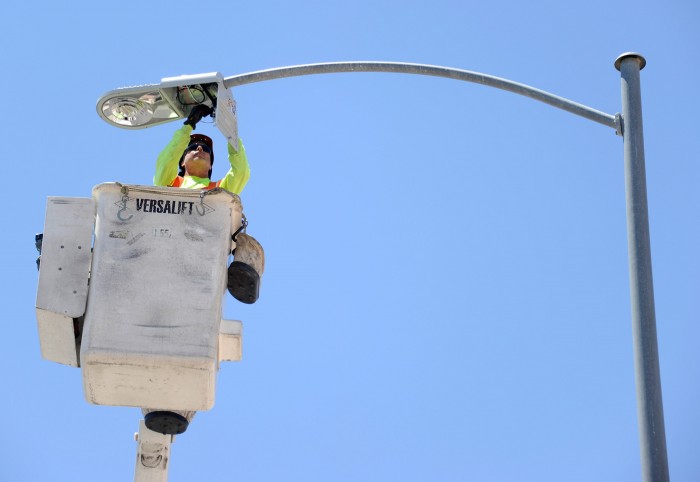LED Streetlights Are Getting a Dark Reception
As light-emitting diodes become cheaper and cities are encouraged to cut their energy use, LED streetlights have sprung up on the roads of many municipalities around America. But residents in those early-adopting cities are now faced with a problem: they don’t like the light.

Until recently, most of the LED streetlights that have been installed have had a bluish tinge. As IEEE Spectrum reports, ever since they’ve been installed, people have been complaining about glare, light pollution, and their effects on wildlife. Even people who actively want to help cut electricity consumption find it a struggle, as the author of the piece, Jeff Hecht, explains:
When my city of Newton, Mass., announced plans to install LED streetlights in 2014, I was optimistic. I’m all for energy conservation, and I was happy with the LED bulbs in my home office. But months later, returning from a week’s vacation in rural Maine, I was shocked to find my neighborhood lit by a stark bluish blaze that washed out almost all of the stars in the night sky.
The reason that LED lighting often looks so blue is one of efficiency. Blue LEDs—the invention of which snagged a Nobel Prize—are more energy-efficient than those of any other color. So white LEDs are actually blue LEDs with added materials that absorb some blue light to re-emit it as yellow. While it’s possible to warm the light further by adding more of the material, that also decreases efficiency. To keep costs down, many cities chose to keep things at the blue end of the spectrum.
But evidence has recently stacked up that blue street lighting isn’t a good idea. In a note issued over the summer, the American Medical Association explained that blue-tinged street lamps “create worse nighttime glare” and “have five times greater impact on circadian sleep rhythms” than conventional street lamps.
LED manufacturers have been trying to solve the problem by creating higher-efficiency red LEDs that can be added to balance the light out. The new hardware is increasingly being used in cities—not that that’s much consolation for Hecht, or anyone else whose streets have taken on a harsh blue pallor.
(Read more: IEEE Spectrum, American Medical Association)
Keep Reading
Most Popular
Large language models can do jaw-dropping things. But nobody knows exactly why.
And that's a problem. Figuring it out is one of the biggest scientific puzzles of our time and a crucial step towards controlling more powerful future models.
The problem with plug-in hybrids? Their drivers.
Plug-in hybrids are often sold as a transition to EVs, but new data from Europe shows we’re still underestimating the emissions they produce.
How scientists traced a mysterious covid case back to six toilets
When wastewater surveillance turns into a hunt for a single infected individual, the ethics get tricky.
Google DeepMind’s new generative model makes Super Mario–like games from scratch
Genie learns how to control games by watching hours and hours of video. It could help train next-gen robots too.
Stay connected
Get the latest updates from
MIT Technology Review
Discover special offers, top stories, upcoming events, and more.